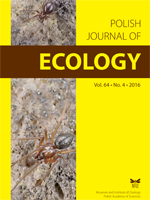Krassimira Ilieva-Makulec, Józef Tyburski, Grzegorz Makulec
Polish Journal of Ecology 64 (4), 547-563, (1 December 2016) https://doi.org/10.3161/15052249PJE2016.64.4.010
KEYWORDS: nematode taxonomic richness, nematode trophic structure, Agroecosystems, Farming system, soil food web evaluation
Agricultural practices in organic farming theoretically are supposed to lead to higher diversity and activity of soil organisms, which correlates with the stability or resilience of the soil system. In a 3-year study, we tested that hypothesis by comparing the nematode abundance, genera composition and community structure in the soil of winter wheat crop under organic and conventional management.
We found the soil type to be a stronger predictor for the total nematodes abundance than the farming system itself. In both systems nematode densities were higher in the sandy than in the clayey soil. Total abundance of nematodes was significantly higher in the organic than conventional farm only in sandy soil and only in the autumn. Significantly more plant feeders was observed in organic than in the conventional crops regardless the soil type. In the clayey soil more bacterial feeders were found in the conventional farm, while in the sandy soil — in the organic one.
Nematode generic richness was higher in the organic (a range of 15–35 genera) than in the conventional crops (a range of 15–29) on most sampling dates. Higher generic diversity (H') in the organic crop than in conventional was found for total nematodes in the clayey soil, and for hyphal feeders in sandy soil. H' for plant feeders were higher under organic than conventional system in both types of soil.
In both farming systems bacterial feeding genera (Rhabditis, Panagrolaimus, Cephalobus and Acrobeloides) dominated in the communities. Plant feeders and omnivores were found among dominant genera only in the clayey soil, first under both systems, the latter only in the organic crops.
The evaluation based on the ecological indices such as Maturity Index, Plant Parasite Index, Enrichment and Structure Index, and ratios between nematode trophic groups, showed that nematode communities under both farming systems most of the time were low matured and the soil food webs strongly disturbed.


